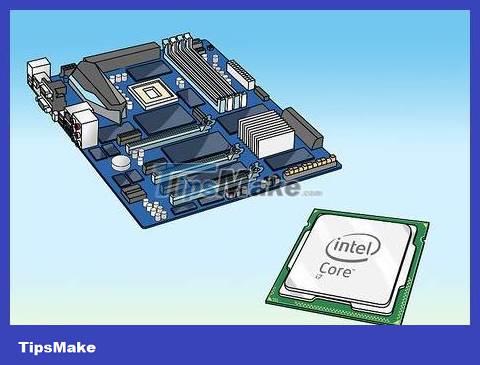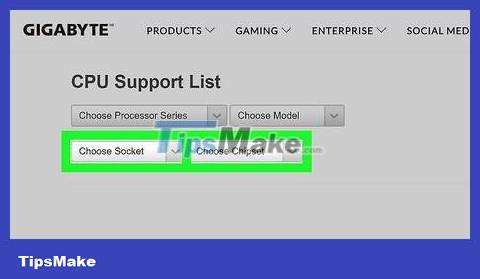How to Upgrade Your Computer's Processor
Select processor

Learn how the processor and motherboard work. A computer motherboard is a large circuit board used to attach other computer components, including the processor. Since the size and connectors of each processor vary depending on the product line, you need to make sure the processor you choose matches your current motherboard.
Tip: You can also replace the motherboard with another one that can support the processor you want to use.

Learn about your computer's limitations. While you can upgrade the processor and motherboard of any Windows computer, upgrading a laptop's processor is usually not possible; Even if your laptop model supports changing the processor, this is a difficult process that can harm your computer more than it helps.

Find your computer's motherboard model . While you can use Command Prompt to find basic motherboard information, using a free service like Speccy will tell you a lot of important information about the motherboard (such as pin type). of the microprocessor).

Determine what type of processor pin the motherboard uses. If you use Speccy to find motherboard information, you'll click on the CPU tab and look at the "Package" heading to determine the pin type.
You can click on the Motherboard tab and look at the "Chipset" heading to see what chip your processor has, which service you use to check processor compatibility. Your manager usually determines this information for you.
If you decide to use Speccy, you can enter your motherboard's name and model number, followed by "socket" and "chipset" into the search engine, then browse the results.
Or, you can always look at the pin type listed on the motherboard, near the CPU pins.

Find the processor that matches your motherboard. You will have to find the processor based on the pin size and chip of your current motherboard:
Visit https://www.gigabyte.com/us/Support/CPU-Support using your computer's web browser.
Click the Choose Socket selection box , then select the motherboard's pin number.
Click the Choose Chipset drop-down box , then click the chip number (usually you'll only see one number here).
Click the "Search" icon to the right of the chip number, then see the names of compatible processors in the window that appears.

Find a new motherboard that matches the processor if needed. While it's easy to type your processor's specs and the phrase "supported motherboards" into a search engine and see the results, navigating your CPU's support page isn't easy. will be easier:
Return to https://www.gigabyte.com/Support/CPU-Support on your computer's browser.
Click the Choose Processor Series selection box , then select the processor name.
Click the Choose Model selection box , then click the processor model.
Click the "Search" icon to the right of the model number, then view the list of compatible motherboards in the "Model" column.

Buy a processor. When you know which processor is suitable for your computer's motherboard, you can choose the one that best suits your budget, needs, and region.
Always check product prices at multiple places to find the best deals. You can buy a processor online at a lower price than in a store.
If you want to buy a new motherboard, be sure to compare prices between websites and stores before ordering.
Install the processor

Turn off and disconnect the computer. Before you move or open the case, make sure the computer is turned off and disconnected from the power source.
Note: For ease of operation, you can remove all peripheral devices (such as mouse, speakers, USB hub, etc.) from the computer. This step is not required if you just want to replace the motherboard.

Place the chassis on a flat surface. Thus, you will easily open the lid of the case.

Open the chassis cover. Some cases require you to unscrew the screws on the case lid, while others just need to unclip or slide the case lid.

Find ways to ground yourself to protect yourself . Here's how to prevent electrostatic discharge problems. Because static electricity can damage delicate computer components, such as the motherboard, you need to take grounding measures during installation.

Find the motherboard. The motherboard looks like a circuit board with many wires attached to it. In most cases, you will find the motherboard at the bottom of the case.
You will probably see the motherboard mounted on the wall of the case.

Remove the existing radiator. The heatsink is mounted above the motherboard, and usually has a large fan on top. To remove the heatsink, you will have to remove it from the motherboard, unscrew it, or push it out.
Because each radiator has a different design and installation procedure, you need to refer to the radiator manual for specific operating steps.

Check the current processor mounting bracket. You will have to install the new processor into the chassis where the current processor is mounted, so knowing the installation direction will help you install it successfully the first time.
Skip this step and the next step if you want to remove the motherboard.

Uninstall the current processor. Carefully remove the square chip-like processor from the motherboard.

Install a new motherboard if necessary. If you want to install a new motherboard, remove the existing one from the case, then install the new one according to the installation instructions (if necessary). The next step is to attach the other components of the computer to the motherboard.

Install the new processor. Only one side of the processor fits into the mounting frame, so don't try to use force; Gently place the processor in the frame and check that it fits.
If the processor is tilted or does not fit into the frame, you can try rotating it 90 degrees until the processor is seated neatly in the frame.
Try not to touch the connectors on the bottom of the processor, as this is not good for the processor.

Install the radiator. Dab some thermal paste on top of the processor, then install the heatsink in its place on the motherboard. Applying thermal paste above the processor will seal the gap between the processor and the heatsink.
Tip: You only need to take an amount of thermal paste the size of a grain of rice.

Attach previously removed components. Depending on your computer, you may have removed one or two cables during installation. If so, be sure to attach those cables to the motherboard before continuing.
This is something to do after you have installed your new motherboard.

Reinstall and start the computer. Once the computer is reassembled and connected to power, you can start the computer and click on the setup menus that appear on the screen.
Because Windows needs to download and install new drivers for the processor, you will be asked to restart the computer after the boot process is complete.
You should read it
- Instructions on how to upgrade RAM on computers and Laptops
- When to upgrade RAM for computers and laptops?
- Replace CPU for Laptop
- Instructions for upgrading BIOS
- A few notes when upgrading for computers
- 8 reasons to upgrade to Raspberry Pi 5
- 5 mistakes when upgrading computers
- Choosing a CPU for a computer
May be interested
- How to upgrade RAM on a Mac
 if your mac shows signs of slowness, upgrading ram is a great solution. this article will show you how to upgrade ram on your mac.
if your mac shows signs of slowness, upgrading ram is a great solution. this article will show you how to upgrade ram on your mac. - Acer and Lenovo simultaneously upgraded to Haswell chips
 both acer and lenovo have introduced new versions of laptops using the latest haswell processor chip platform from intel.
both acer and lenovo have introduced new versions of laptops using the latest haswell processor chip platform from intel. - 8 reasons for not upgrading the old computer
 gamers or computer users for professional video editing always need to increase the configuration to improve performance. however, ordinary users can save money by being faithful to existing computers. here are the reasons why you don't need to hurry up and upgrade your old computer.
gamers or computer users for professional video editing always need to increase the configuration to improve performance. however, ordinary users can save money by being faithful to existing computers. here are the reasons why you don't need to hurry up and upgrade your old computer. - Panasonic upgraded the configuration for ultra-durable computers
 models include toughbook cf-19, cf-31, cf-53 and cf-h2 not only get more powerful processor but also run on the new version of windows 8 pro operating system.
models include toughbook cf-19, cf-31, cf-53 and cf-h2 not only get more powerful processor but also run on the new version of windows 8 pro operating system. - Instructions for upgrading BIOS
 upgrading the bios for a computer can help your system boot faster, overcome some compatibility issues and improve performance.
upgrading the bios for a computer can help your system boot faster, overcome some compatibility issues and improve performance. - How to Upgrade an Overclocked Pentium G3258 Processor to Windows 10
 if you've overclocked your pentium g3258, you may have ran into problems when you tried to upgrade to windows 10. start with step one, below, to learn how to upgrade an overclocked system to windows 10. before installing windows 10, go to...
if you've overclocked your pentium g3258, you may have ran into problems when you tried to upgrade to windows 10. start with step one, below, to learn how to upgrade an overclocked system to windows 10. before installing windows 10, go to... - Razer Blade upgrade configuration
 manufacturer razer has officially unveiled a new gaming laptop with a core i7 processor and nvidia geforce gtx 660m graphics card.
manufacturer razer has officially unveiled a new gaming laptop with a core i7 processor and nvidia geforce gtx 660m graphics card. - Instructions on how to upgrade RAM on computers and Laptops
 installing more ram is the most effective way to speed up your computer. even if your computer is a new computer, after only a few years of use you will have to install more ram to ensure better machine speed. besides new operating systems also require the use of more memory. when a computer does not have enough ram it will exchange data streams with the hard drive, and that is the reason your system is working slowly.
installing more ram is the most effective way to speed up your computer. even if your computer is a new computer, after only a few years of use you will have to install more ram to ensure better machine speed. besides new operating systems also require the use of more memory. when a computer does not have enough ram it will exchange data streams with the hard drive, and that is the reason your system is working slowly. - 9 simple and cheap ways to upgrade your computer
 the following ways will help your computer become younger and more energetic, especially giving users great comfort when sitting in front of a computer.
the following ways will help your computer become younger and more energetic, especially giving users great comfort when sitting in front of a computer. - Ways to upgrade desktop computers to optimize usage according to needs
 join tipsmake to discover the simplest ways to quickly upgrade your old desktop computer at home.
join tipsmake to discover the simplest ways to quickly upgrade your old desktop computer at home.










 How to Apply Thermal Paste
How to Apply Thermal Paste How to Test a PC Power Supply
How to Test a PC Power Supply How to Clean Up Your Computer and Fix Errors for Free
How to Clean Up Your Computer and Fix Errors for Free How to Determine Why Your Computer Won't Start
How to Determine Why Your Computer Won't Start How to Clean Game Discs
How to Clean Game Discs How to Clean a Laptop Screen Using Household Products
How to Clean a Laptop Screen Using Household Products